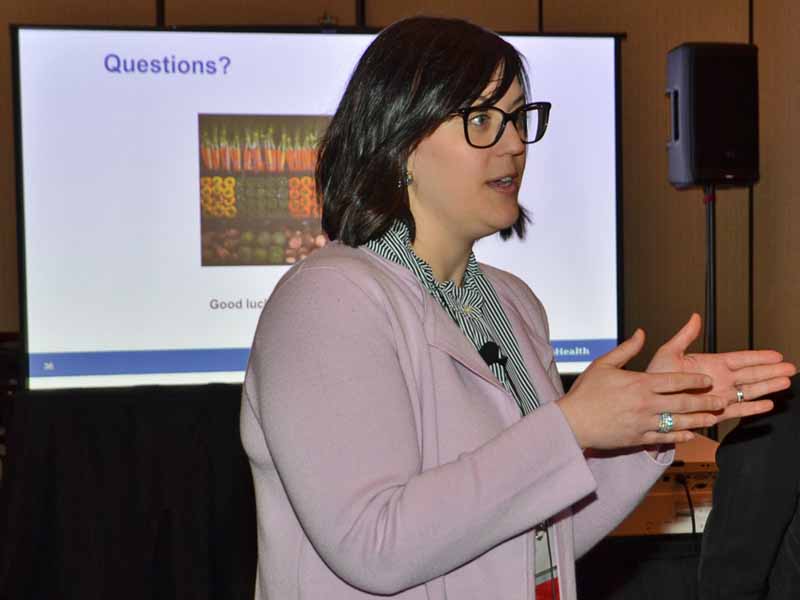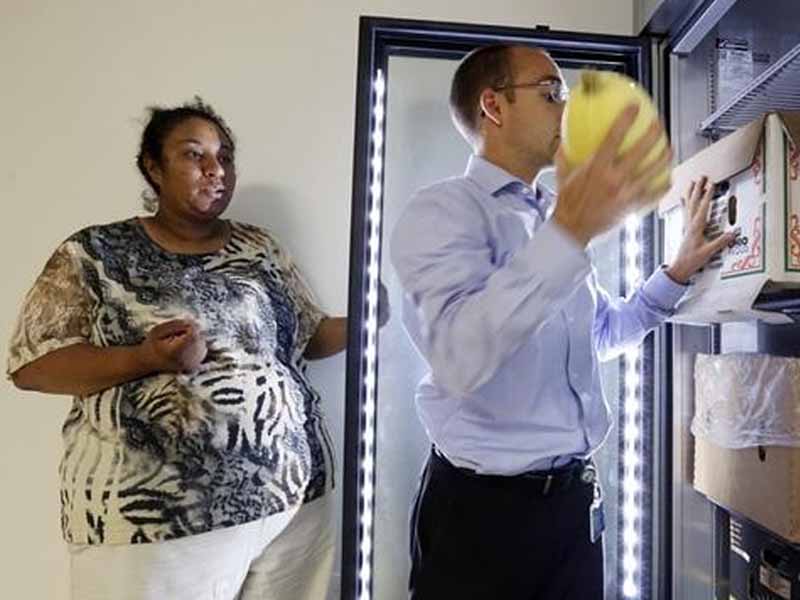Residency Program Solutions Conference
Food is Health Pilot Improves Patients' Diabetes Markers

Laurie Hommema, M.D., tells audience members at the recent Residency Program Solutions conference that her residency's Food is Health program has overcome some unexpected challenges, including how to dispose of wooden pallets after food deliveries to the clinic. "We found someone on Craigslist who did pallet art, and he came and picked them up."
April 10, 2019 03:47 pm Sheri Porter Kansas City, Mo. – An Ohio-based family medicine residency program has discovered a way to encourage good nutrition in patients with diabetes whose households also struggle with food insecurity.
Even better, outcomes one year after the start of the Food is Health program -- initiated by the OhioHealth Riverside Family Medicine Residency Program in Columbus -- show patient weight loss, improved blood sugars and positive attitudes.
Details about the program and its successes were highlighted at the Residency Program Solutions portion of the AAFP's Residency Education Symposium held here April 5-9.
Residency program director Laurie Hommema, M.D., along with Miriam Chan, Pharm.D., program director of the Riverside Methodist Hospital Quality and Safety Fellowship and director of scholarly activity and population health at the residency program, led the April 8 session.
Defining Food Insecurity
Chan defined food insecurity as a condition that limits a person's access to the food needed for an active, healthy lifestyle. She described three levels of food insecurity:
- low, when availability of food is a concern but nobody is going hungry;
- medium, when food insecurity is an issue but adults in the household eat less and can provide for younger family members; and
- severe, when both adults and children suffer and go hungry.
She pointed to results of a 2014 Hunger in America survey that show food insecurity exists in every U.S. county.
In fact, one in six adults and one in five children suffer from food insecurity. That's about 49 million people, including 16 million hungry kids, said Chan.
"People who have a problem getting enough food to eat adapt and use coping strategies that put them at risk for chronic diseases such as diabetes and hypertension," said Chan.
The same survey found that 24% of households had at least one member in poor health, 33% had a member with diabetes, 58% had a member with high blood pressure, and 66% of households had to choose between food and medical care.
In short, the U.S. Department of Agriculture estimates that nearly 13% of all U.S. households experience food insecurity.
Story Highlights
Recognizing the Problem
In 2017, Riverside Family Medicine Residency screened 315 patients who had an office visit from June 20 to June 30 for food security using a two-question tool.
Patients were asked if, during the past 12 months, they worried about or actually experienced running out of food before there was money to buy more. Of the screened patients, 133 (43%) were identified as food-insecure.
Establishing the Pilot
At this point, the residency had identified a need within its patient base and decided to focus on patients with diabetes.
Screening was built into the electronic health record. "Every time a patient with diabetes came into the office, an alert would pop up to screen the patient with the two questions," said Hommema. If agreeable, those who screened positive were enrolled in the Food is Health program.
Next step -- finding space in the office for a pseudo-grocery store. An empty radiology suite fit the bill and the program's hospital affiliate, OhioHealth Riverside Methodist Hospital, purchased two commercial refrigerators and some shelves totaling about $12,000.
"Our focus was really on fresh fruits and vegetables, but we wanted to have shelf-stable items, as well … so people would have some backup supplies at home," said Hommema.
The program relies on $30,000 budgeted for drugs and supplies to purchase food at wholesale prices.
Working out Details
About one third of the clinic's patients with diabetes screened positive for food insecurity. And as of September 2018, the clinic had 68 patients enrolled in the program, and more than 40 of them were coming to the practice weekly or every other week.

It's time to pick out weekly produce at the OhioHealth Riverside Family Medicine Residency, and Max Farenwald, an Ohio University medical student, is happy to assist a patient enrolled in the Food is Health program.
"We provide food for the whole family and purchase based on the number of patients and family size," said Hommema. "Because one of the tenets of our program as we were setting it up is that we didn't want to just provide food for the individual, because we know in food-insecure homes, food is rationed and given to the most vulnerable.
"Often families have a lot of children, and we knew the food would be given to the children and the patient would not benefit."
Patients' families are encouraged to participate. And so when patients, often accompanied by kids, spouses, grandparents, aunts and uncles, come to their weekly or biweekly 20-minute visit, they attend a brief educational session and pick out fresh produce and pantry items.
"We have a family with three little girls who come in every week to pick out their food, and they just keep asking us when we're going to get plums again. It was the first time they'd ever had them, and they loved them," said Hommema.
It's been fun to expand patients' palates by introducing new produce and then teaching them how to make cauliflower rice, kale chips and oven-roasted radishes, she added.
Participants also receive a recipe that uses the food included on each pickup day.
"Recipes are simple -- no more than five ingredients -- and we try to make them seasonal to keep people engaged and excited," said Hommema.
When organizers realized they were supplying produce to families with limited kitchen utensils, the program purchased vegetable peelers, measuring cups and cutting boards and taught families how to, for instance, prepare an avocado.
"We plan for families to take 15 pounds of produce home; that's $8 weekly per individual for produce," said Hommema. Canned goods for two months runs about $6 per person.
It's money well spent, she said. "That's far less than the majority of diabetic medications other than metformin. This is a really affordable intervention when you're talking about diabetic treatment."
An added bonus is that residents love working the program.
Patient interaction and food selection is facilitated by residents and a few students from affiliated medical schools. "We built this into our residents' ambulatory improvement and community health rotations," said Hommema.
"It has become a favorite, and when folks are out sick, our residents actually argue about who gets to cover Food is Health," she added.
Resident feedback featured in the slide set at the symposium included these comments: "This is what my heart needed." "Wherever I end up practicing, I want to do this in my office!" And, "This reminded me why I became a physician -- I lost that."
Sharing Outcomes
Presenters teased the audience by not sharing their outcomes until they were well into the session.
These results were worth the wait.
Weight loss was an early indicator, and patients got excited about that very quickly, said Hommema. Within the first month, individual patients had shed seven, eight and even 12 pounds.
"At two months, we had patients who had lost 30 pounds, and they were seeing their physicians and were doing fine medically," she added.
Blood sugars also improved. One patient reported that blood sugars previously above 200 now were averaging 95-120. Another said blood sugars near 500 were leveling out at 110-200.
Hommema also shared one of her favorite stories. One patient, a bus driver, disclosed that he was about to lose his license -- and ultimately his job -- because his hemoglobin A1c level wouldn't budge from 11 and his physician insisted it was time to start on insulin.
"We told the patient this program was his last-ditch effort, and within three months, his A1c was down to 7," said Hommema.
Almost as gratifying have been personal comments from patients. "This program has changed my life and the way I eat," said one. "Children love coming and picking out new food," said another." Another patient reported her granddaughter had lost 20 pounds.
"These kinds of things keep us going," said Hommema. "And hopefully, we're also reversing some of the early prediabetes in family members."